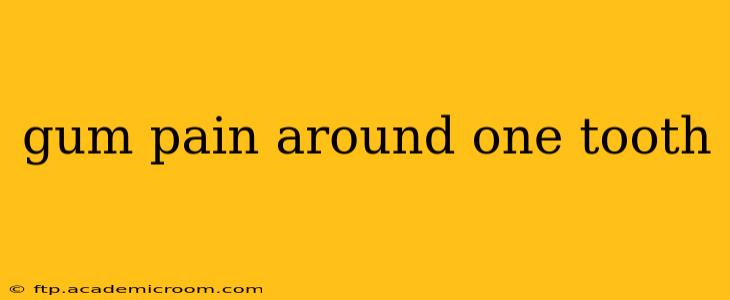Experiencing gum pain localized around a single tooth can be unsettling, but understanding the potential causes can help alleviate anxiety and guide you towards effective treatment. This localized pain often indicates a specific dental problem requiring attention. Ignoring it can lead to more serious issues, so let's delve into the possible culprits and what you can do.
What Causes Gum Pain Around One Tooth?
Several factors can trigger localized gum pain. Identifying the root cause is crucial for effective treatment. The most common culprits include:
-
Gingivitis: This is an early stage of gum disease, characterized by inflammation and redness of the gums. It's often caused by poor oral hygiene, allowing plaque (a sticky film of bacteria) to build up along the gumline. The inflammation leads to pain, tenderness, and sometimes bleeding gums, often localized to a specific area if the plaque buildup is concentrated.
-
Periodontitis: A more advanced stage of gum disease, periodontitis involves the destruction of the tissues and bone supporting the teeth. This can cause significant pain around the affected tooth, along with loosening of the tooth, pus formation, and persistent bad breath. Unlike gingivitis, periodontitis often requires professional intervention.
-
Abscess: A localized infection around the tooth or gum can form a pus-filled pocket (abscess). This is extremely painful and requires immediate dental attention. The pain is often intense and throbbing, localized to the area of the abscess.
-
Dental Caries (Cavities): While cavities primarily affect the tooth enamel, advanced decay can extend to the pulp (the inner part of the tooth containing nerves and blood vessels), causing intense pain that can radiate to the surrounding gums. This pain might be sharp, persistent, or triggered by hot or cold temperatures.
-
Trauma: A blow or injury to the tooth or gum can cause inflammation and pain. This could be from a fall, accident, or even aggressive brushing or flossing.
-
Impacted Tooth: A partially erupted or impacted tooth can cause pressure and inflammation on the surrounding gums, resulting in pain.
-
Dental Procedure Complications: Pain around a tooth can sometimes be a complication of a recent dental procedure, like a filling, root canal, or extraction. If the pain is severe or persistent, contact your dentist.
How to Treat Gum Pain Around One Tooth
Treatment depends entirely on the underlying cause. It's crucial to schedule an appointment with your dentist as soon as possible. They can accurately diagnose the problem and recommend the appropriate treatment, which may include:
-
Professional Cleaning: For gingivitis, a thorough professional cleaning to remove plaque and tartar is often sufficient.
-
Antibiotics: For infections like abscesses or severe periodontitis, antibiotics may be prescribed to fight the infection.
-
Root Canal: If the pain stems from a deeply decayed tooth, a root canal might be necessary to remove the infected pulp and save the tooth.
-
Extraction: In some cases, such as severely damaged or infected teeth, extraction might be the only option.
-
Pain Relief Medication: Over-the-counter pain relievers like ibuprofen or acetaminophen can provide temporary relief from pain and inflammation. However, these only mask the symptoms and don't treat the underlying problem.
What if the Gum Pain is Severe?
Severe, throbbing pain, especially accompanied by swelling or fever, requires immediate dental attention. Don't delay seeking professional help in these situations. A dental abscess, for instance, needs prompt treatment to prevent the spread of infection.
Can I Prevent Gum Pain Around One Tooth?
Maintaining good oral hygiene is the best preventive measure. This includes:
- Brushing: Brush your teeth thoroughly twice a day with fluoride toothpaste.
- Flossing: Floss daily to remove plaque and food particles from between your teeth.
- Regular Dental Checkups: Schedule regular visits to your dentist for professional cleanings and checkups. Early detection and treatment of gum disease are key to preventing more severe problems.
- Healthy Diet: A balanced diet can contribute to overall oral health.
By understanding the potential causes of gum pain around one tooth and taking proactive steps towards maintaining good oral health, you can significantly reduce your risk of experiencing this discomfort. Remember, early detection and prompt treatment are essential for preventing more serious complications. Don't hesitate to contact your dentist if you're experiencing any persistent or concerning gum pain.
